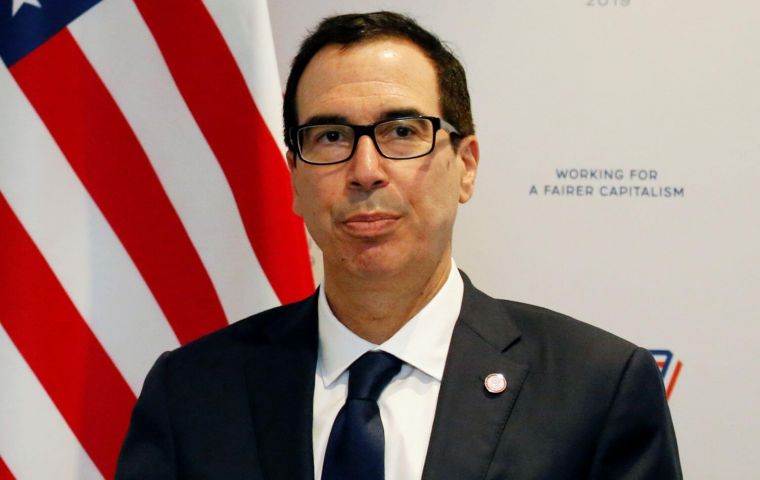MercoPress. South Atlantic News Agency
Fed expected to further lower interest rate as trade tensions with China increase
 Treasury Secretary Steven Mnuchin started a formal process to address what the US says is the “unfair competitive advantage” in trade that China gets with a cheaper Yuan
Treasury Secretary Steven Mnuchin started a formal process to address what the US says is the “unfair competitive advantage” in trade that China gets with a cheaper Yuan Federal Reserve Chair Jerome Powell, who last week cut U.S. interest rates as an insurance policy against the effects of “simmering” trade tensions, may need to buy more coverage after the United States late on Monday designated China a currency manipulator.
The move by Treasury Secretary Steven Mnuchin starts a formal process to address what the United States says is the “unfair competitive advantage” in trade that China gets with a cheaper Yuan.
Stock futures dropped and Treasury futures rose as traders bet this latest escalation of the U.S.-China trade war will slow the U.S. economy further, forcing the Fed to respond with deeper rate cuts to ease financial conditions and encourage businesses to hire and spend.
The decision is “a shocker,” said Tim Duy, an economics professor at the University of Oregon.
If last week's rate cut was Fed policymakers' way of insuring against a possible fire, he said, “The potential for the fire has risen – and that potential is something they are going to react to.”
Interest rate futures now show traders see a nearly 40per cent chance the Fed will lower borrowing costs by a half-a-percentage-point next month, up from less than 2per cent on Friday and 30per cent earlier Monday.
U.S. President Donald Trump has been ratcheting up tariffs on China with the aim of pressuring the world's second-largest economy to strike a trade deal with terms more favorable to Americans, and for months had been calling on the Fed to lower interest rates to support the U.S. economy while he did so.
But after the Fed last week cut its target range for the benchmark rate by a quarter of a percentage point, to 2per cent-2.25per cent, Trump said the central bank had “let us down.”
A bigger rate cut, he said, would have helped the United States keep pace with China and other countries.
The next day Trump announced new 10per cent tariffs on US$300 billion worth of Chinese imports starting on Sept. 1.
On Monday China let its currency weaken beyond the 7-yuan-per-dollar level for the first time in more than a decade. Beijing also stopped purchases of U.S. agricultural goods, inflaming a trade war that has roiled financial markets, disrupted supply chains and slowed global growth.
“Are you listening Federal Reserve?” Trump tweeted after the Yuan's decline, labeling the devaluation “manipulation” just hours before the Treasury made the designation official.
Though trade is a much smaller part of the overall U.S. economy than still-healthy consumer spending, trade uncertainty has dragged on growth, with businesses trimming spending last quarter and factories cutting production.
And while the Fed does not set, and Powell takes pains not to comment on, U.S. trade policy or the value of the U.S. currency, escalating trade tensions boost the odds that what Powell called a “mid-cycle” interest-rate cut may end up being the start to a deeper, longer episode of policy easing.
“The Fed doesn't want the market to think that they are capitulating to a policy or trade fight,” said Bank of the West economist Scott Anderson. “But the Fed will be responding to a threat to the economic outlook. The threat is real now.”




Top Comments
Disclaimer & comment rulesCommenting for this story is now closed.
If you have a Facebook account, become a fan and comment on our Facebook Page!